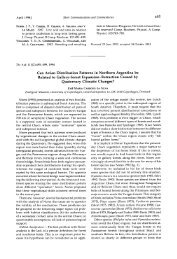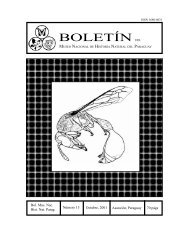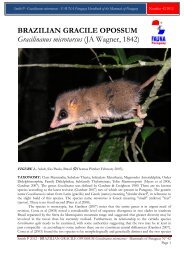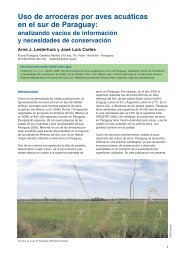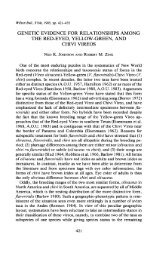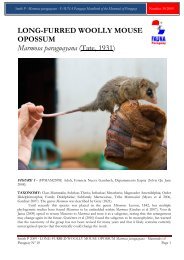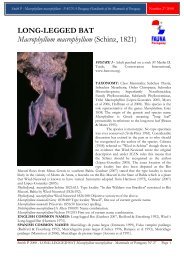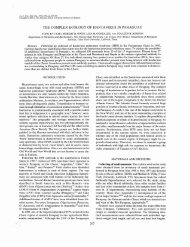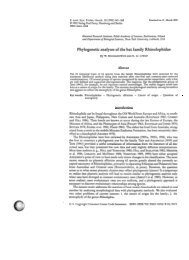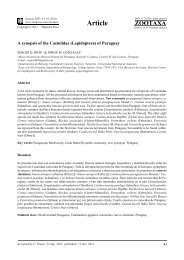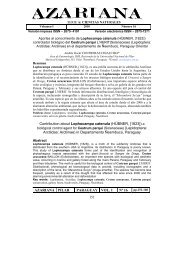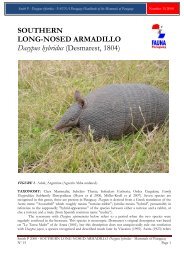hbk mammals vol 2 - FAUNA Paraguay
hbk mammals vol 2 - FAUNA Paraguay
hbk mammals vol 2 - FAUNA Paraguay
You also want an ePaper? Increase the reach of your titles
YUMPU automatically turns print PDFs into web optimized ePapers that Google loves.
Smith P 2009: <strong>FAUNA</strong> <strong>Paraguay</strong> Handbook of the Mammals of <strong>Paraguay</strong> Vol 2: Xenarthra<br />
ESP: Mulita orejuda (Redford & Eisenberg 1992), Mulita (González 2001), Mulita pampeana (Chebez<br />
2001), Mulita chica (Chebez 2001). The Spanish name "Mulita" or "little mule" stems from the long,<br />
donkey-like ears present in members of this genus. Despite the name "orejuda" (meaning big ears) this<br />
species has proportionately the shortest ears of the <strong>Paraguay</strong>an Dasypus. "Mulita chica" (little Mulita) is<br />
in direct comparison to the Nine-banded Armadillo, the only Dasypus sympatric with it over much of<br />
its Argentinean range. "Mulita pampeana" reflects its preference for grassland-type habitats such as<br />
those of the Argentinean pampas.<br />
GUA: Tatu mburica MPA (Hamlett 1939). The Guaraní name Tatu mburica is the most frequently<br />
utilised in <strong>Paraguay</strong> for this species, the Spanish names rarely being heard in everyday speech.<br />
However it is rare for this species to be encountered and identified specifically, so it is just as likely to<br />
be confused with , novemcinctus Dasypusthe<br />
Tatu hu. "Tatu mburica" means "Donkey armadillo" in<br />
reference to the long ears of the species.<br />
DES: "Long-nosed" Armadillos have a broad, depressed body, an obtusely-pointed rostrum, long,<br />
pointed ears and short legs. The carapace consists of two immobile plates, the scapular and pelvic<br />
shields separated by 6 or 7 movable bands connected to each other by a fold of hairless skin. The<br />
carapace is mostly dull brownish-grey to brownish-yellow, distinctly paler than other <strong>Paraguay</strong>an<br />
Dasypus and with a very light covering of hair. Frequently there is a paler yellowish lateral line that is<br />
more visible in some individuals than others. The scales of the anterior edge of the movable bands are<br />
darker than the rest of the dorsum. Scutes on the movable bands are triangular in shape, but those on<br />
the main plates are rounded. The number of scutes present on the fourth movable band varies from<br />
50 to 62, with a mean of 54 (Diaz & Barquez 2002, Hamlett 1939). The head is thin and triangular<br />
with a sloping forehead and long, mobile ears with rounded tips that are not separated by armour at<br />
the base. The tail is short compared to other Dasypus (60-70% body length), broad at the base and<br />
narrowing towards the tip. There are four toes on the forefeet (characteristic of the Subfamily<br />
Dasypodinae), the middle two much the longest, and five on the hindfeet. The underside is naked and<br />
pink-grey. Females possess four mammae. CR: Steeply descending frontal bone. DF: Armadillos lack<br />
true teeth. "Long-nosed" armadillos have single-rooted, peg-like teeth that lack enamel. Dental<br />
formula 6/8=28. CN: 2n=64. FN=76. (Gardner 2007).<br />
Dasypus hybridus. Photo courtesy of<br />
www.skullsunlimited.com<br />
Dasypus hybridus. Photo courtesy of<br />
www.skullsunlimited.com<br />
TRA: Dasypus prints can be distinguished from those of other<br />
armadillos by their long, pointed toes with four toes on the<br />
forefoot and five on the hindfoot. However they generally leave<br />
the impression of only the two central toes on the forefeet<br />
(though sometimes the outer toe is also visible) and three central<br />
toes on the hindfeet. Given a full print, the hindfoot has a pointed<br />
heel with three long, somewhat pointed central toes and two,<br />
much shorter, outer toes set well back towards the heel. The<br />
forefoot has the inner toe much reduced and it rarely leaves an<br />
impression.<br />
MMT: The "intermediate" "long-nosed armadillo" in <strong>Paraguay</strong>.<br />
TL: 45.95cm (39.7-49.8cm); TA: 16.84cm (13.2-19.1cm); FT:<br />
6.73cm (5.5-7.3cm); EA: 2.51cm (2.3-2.8cm); WT: 1.5kg (1.09-<br />
2.04kg). (Redford & Eisenberg 1992, González 2001). Hamlett<br />
(1939) gives the following mean measurements of preserved<br />
specimens for this species Head 7.5cm; Body: 24cm; TA:<br />
15.7cm; EA: 2.33cm (2-3.5cm).<br />
SSP: This species is intermediate in size between the other two<br />
"long-nosed armadillos" in <strong>Paraguay</strong> and is characterised by its<br />
shorter ears (25-30% of head length) and tail (67-70% of body<br />
length) which give it a distinctive appearance. Furthermore it is<br />
paler in colouration than both the other species, being distinctly<br />
40



